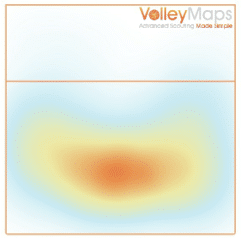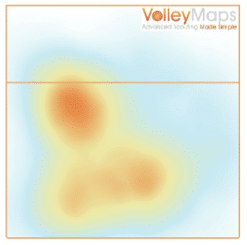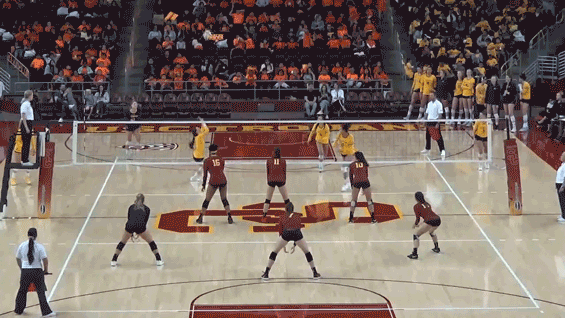Middle-Middle Defense in Volleyball
The first time I heard of Carl McGown, I thought he was a fool. I read an article about how most balls go to the middle of court, and most of them landed at least 10’ in from the end line. Fortunately for me, I knew this to be nonsense. Your middle-back player was supposed to stand just about on the end line and charge forward into the play. Remember: “everything above your waist is out!” Since I knew this to be true, I sent an email to this McGown guy letting him know that he couldn’t possibly be right.
His response: “make your own damn chart!”
I got three matches in before I realized that Carl might just be on to something and that I needed to get to a Gold Medal Squared clinic to figure out what this middle-middle thing was all about.
*The first time I ever charted attacks it didn’t look quite this pretty. However, the results I found were almost the same.

That first interaction with Carl and GMS made a very strong impression on me. So much so that “charting” became a bit of an obsession of mine. As a club coach that time, I started charting opposing teams (and my own) whenever I had some downtime. Now, years later, only one thing has changed: the amount of data I have has increased by several orders of magnitude. As an assistant coach with the USA Women’s National Team, I feel confident in saying that I’ve charted more attacks than anybody else in the world.
At GMS clinics, we learn that the most important part of designing a defensive system is:
Put your best defenders where the most balls go (principles are liberating).
At USA, we’re kind of obsessed with learning where balls go. Last year alone, I charted over 10,000 attacks, recording where every ball went and where to best position a defender for that attack. Over these past few years, I’ve come to know two things:
- Middle-middle is a really good place to stand against 90, maybe 95% of attackers.
- The other 5-10% of hitters can be REALLY frustrating to defend.
Both of these hitters are excellent players, but pose problems in slightly different ways. A defense can set up in a fairly predictable way against the hitter on the left. The middle-back defender can stay “middle-middle”, the left-back can read, the left-front can come to 10 x 10, and the right-back defender can just look like she’s ready while her teammates make all the digs.

Player (2), however, is a slightly different story. This player because she has an excellent sharp angle shot AND an excellent deep corner shot. In this case, the left-back player is stressed quite a bit. She must read “can she hit at me” very quickly and make a decision on whether to stay on the sharp angle, or get in line with the deep corner shot. The middle-back player will get quite a few balls in middle-middle, but will also need to help with the deep corner shot as well. In this case, the ability to read and play balls overhead will be critical.

Clearly this player has range, with attacks going sharp cross, toward the corner, and even a fair amount of tip. However, her predominant shot is in the high 1/6 seam, and in the last 10’ of the court.
It’s these situations that require us as coaches to make some tough decisions.
How would you defend this hitter?
Would you shade the middle-back defender over or bring the right-back defender way off the line? Would you play for the tips or let them go and hope you can read and react? We’d love to hear your thoughts in the comments!
As a reminder, “put your best defensive players where most of the balls go” doesn’t necessarily mean “put your libero in middle middle.” For many of us, our outsides or event middles (yes, in club ball there’s some pretty good middles) may be our best defensive players. This is a great example of what we mean by “principles are liberating.” They allow coaches the flexibility to make sound decisions based on the ability of their players.
Joe Trinsey – USA Women’s Volleyball Technical Coordinator
